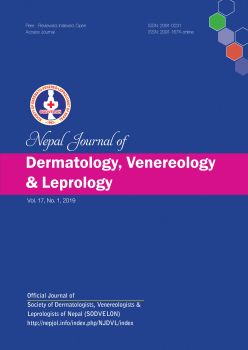Pattern of Pediatric Dermatoses in a Tertiary Referral Centre, Nepal
DOI:
https://doi.org/10.3126/njdvl.v17i1.23249Keywords:
Eczema, Ethnic Groups, Mycoses, Pyoderma, Nepal, Skin Diseases, InfectiousAbstract
Introduction: Dermatological problems constitute at least one third of all outpatient visits to a pediatrician and similar number of all visits to a dermatologist involve children.Children are often exposed to climatic and social conditions that make them more likely to develop skin infections and skin injuries.Little is known about the impact of pediatric skin disease on health care systems in developing countries like Nepal. So, data on this study can be useful in monitoring changes in disease trends in children and planning health care programs.
Objectives: To know the current status of disease trends and ethnic distribution of common dermatoses among children (hospital based) in this geographical locality.
Materials and Methods: All children, 14 years and below, attending the dermatology out-patient department with any dermatoses were enrolled in the study. The diagnosis was made by dermatologists based on detailed history and appropriate investigations. Patients were divided into four different age groups.
Results: A total of 424 children with skin related symptoms were enrolled in this study. The mean age of this population was 6.30 years and it ranged from 0.05(19 days) to14 years. A total of 146 infective and 278 non-infective dermatoses were encountered as the primary diagnosis. Infections and infestations were the most common group of disorders (34.4%, 146 cases), followed by dermatitis and eczemas (32.5%, 138 cases). Fungal infections were the most common infective conditions (11.6%, 49 cases).
Conclusion: Infections and infestations were the most common etiologic group of disorders followed by dermatitis and eczemas. Fungal infections were the most common infective conditions followed by pyoderma.
Downloads
Downloads
Published
How to Cite
Issue
Section
License
Copyright on any research article is transferred in full to Nepal Journal of Dermatology, Venereology & Leprology upon publication. The copyright transfer includes the right to reproduce and distribute the article in any form of reproduction (printing, electronic media or any other form).




